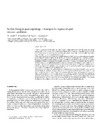Identificador persistente para citar o vincular este elemento:
https://accedacris.ulpgc.es/jspui/handle/10553/43169
| Campo DC | Valor | idioma |
|---|---|---|
| dc.contributor.author | Favalli, M. | en_US |
| dc.contributor.author | Karátson, D. | en_US |
| dc.contributor.author | Yepes, J. | en_US |
| dc.contributor.author | Nannipieri, L. | en_US |
| dc.contributor.other | Yepes, Jorge | - |
| dc.contributor.other | Favalli, Massimiliano | - |
| dc.contributor.other | Nannipieri, Luca | - |
| dc.contributor.other | Nannipieri, Luca | - |
| dc.date.accessioned | 2018-11-21T13:07:39Z | - |
| dc.date.available | 2018-11-21T13:07:39Z | - |
| dc.date.issued | 2014 | en_US |
| dc.identifier.issn | 0169-555X | en_US |
| dc.identifier.uri | https://accedacris.ulpgc.es/handle/10553/43169 | - |
| dc.description.abstract | In nature, several types of landforms have simple shapes: as they evolve they tend to take on an ideal, simple geometric form such as a cone, an ellipsoid or a paraboloid. Volcanic landforms are possibly the best examples of this “ideal” geometry, since they develop as regular surface features due to the point-like (circular) or fissure-like (linear) manifestation of volcanic activity. In this paper, we present a geomorphometric method of fitting the “ideal” surface onto the real surface of regular-shaped volcanoes through a number of case studies (Mt. Mayon, Mt. Somma, Mt. Semeru, and Mt. Cameroon). Volcanoes with circular, as well as elliptical, symmetry are addressed. For the best surface fit, we use the minimization library MINUIT which is made freely available by the CERN (European Organization for Nuclear Research). This library enables us to handle all the available surface data (every point of the digital elevation model) in a one-step, half-automated way regardless of the size of the dataset, and to consider simultaneously all the relevant parameters of the selected problem, such as the position of the center of the edifice, apex height, and cone slope, thanks to the highly performing adopted procedure. Fitting the geometric surface, along with calculating the related error, demonstrates the twofold advantage of the method. Firstly, we can determine quantitatively to what extent a given volcanic landform is regular, i.e. how much it follows an expected regular shape. Deviations from the ideal shape due to degradation (e.g. sector collapse and normal erosion) can be used in erosion rate calculations. Secondly, if we have a degraded volcanic landform, whose geometry is not clear, this method of surface fitting reconstructs the original shape with the maximum precision. Obviously, in addition to volcanic landforms, this method is also capable of constraining the shapes of other regular surface features such as aeolian, glacial or periglacial landforms. | en_US |
| dc.language | eng | en_US |
| dc.publisher | 0169-555X | |
| dc.relation.ispartof | Geomorphology | en_US |
| dc.source | Geomorphology[ISSN 0169-555X],v. 221, p. 139-149 | en_US |
| dc.subject | 250607 Geomorfología | en_US |
| dc.subject | 250621 Vulcanología | en_US |
| dc.subject.other | Surface fitting | en_US |
| dc.subject.other | Volcano shape | en_US |
| dc.subject.other | Regular surface | en_US |
| dc.subject.other | DEM-based morphometry | en_US |
| dc.title | Surface fitting in geomorphology - Examples for regular-shaped volcanic landforms | en_US |
| dc.type | info:eu-repo/semantics/Article | es |
| dc.type | Article | es |
| dc.identifier.doi | 10.1016/j.geomorph.2014.06.009 | |
| dc.identifier.scopus | 84903438528 | - |
| dc.identifier.isi | 000340338000011 | - |
| dcterms.isPartOf | Geomorphology | |
| dcterms.source | Geomorphology[ISSN 0169-555X],v. 221, p. 139-149 | |
| dc.contributor.authorscopusid | 8340407400 | - |
| dc.contributor.authorscopusid | 6602341669 | - |
| dc.contributor.authorscopusid | 16314521900 | - |
| dc.contributor.authorscopusid | 35225302600 | - |
| dc.description.lastpage | 149 | - |
| dc.description.firstpage | 139 | - |
| dc.relation.volume | 221 | - |
| dc.investigacion | Ingeniería y Arquitectura | en_US |
| dc.type2 | Artículo | en_US |
| dc.identifier.wos | WOS:000340338000011 | - |
| dc.contributor.daisngid | 645627 | - |
| dc.contributor.daisngid | 1509808 | - |
| dc.contributor.daisngid | 2313783 | - |
| dc.contributor.daisngid | 3314252 | - |
| dc.identifier.investigatorRID | J-6653-2012 | - |
| dc.identifier.investigatorRID | No ID | - |
| dc.identifier.investigatorRID | No ID | - |
| dc.identifier.investigatorRID | No ID | - |
| dc.utils.revision | Sí | en_US |
| dc.contributor.wosstandard | WOS:Favalli, M | |
| dc.contributor.wosstandard | WOS:Karatson, D | |
| dc.contributor.wosstandard | WOS:Yepes, J | |
| dc.contributor.wosstandard | WOS:Nannipieri, L | |
| dc.date.coverdate | Septiembre 2014 | |
| dc.identifier.ulpgc | Sí | es |
| dc.description.sjr | 1,431 | |
| dc.description.jcr | 2,785 | |
| dc.description.sjrq | Q1 | |
| dc.description.jcrq | Q1 | |
| dc.description.scie | SCIE | |
| item.grantfulltext | open | - |
| item.fulltext | Con texto completo | - |
| crisitem.author.dept | GIR IOCAG: Geología Aplicada y Regional | - |
| crisitem.author.dept | IU de Oceanografía y Cambio Global | - |
| crisitem.author.dept | Departamento de Ingeniería Civil | - |
| crisitem.author.orcid | 0000-0001-5039-1482 | - |
| crisitem.author.parentorg | IU de Oceanografía y Cambio Global | - |
| crisitem.author.fullName | Yepes Temiño, Jorge | - |
| Colección: | Artículos | |
Los elementos en ULPGC accedaCRIS están protegidos por derechos de autor con todos los derechos reservados, a menos que se indique lo contrario.
